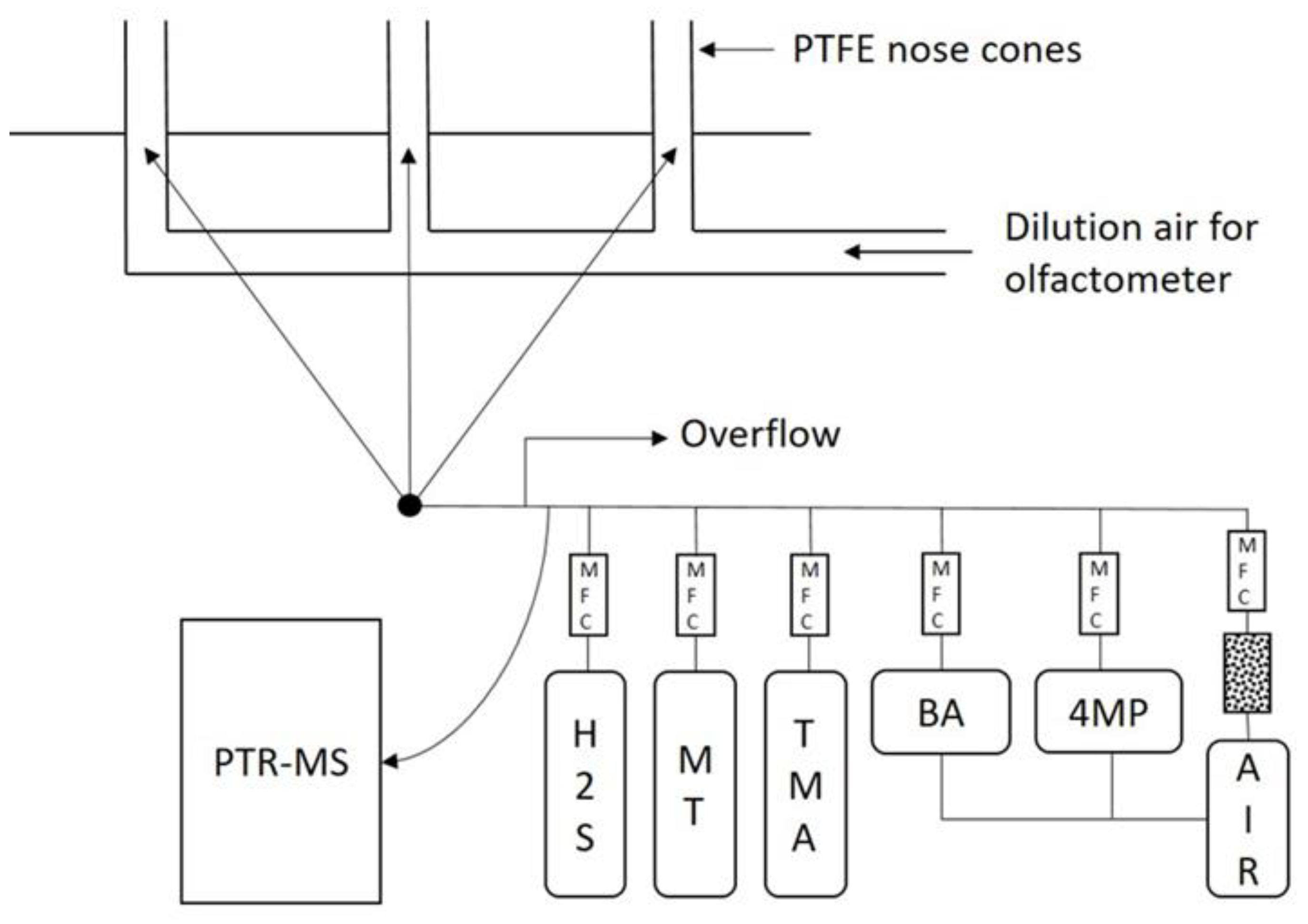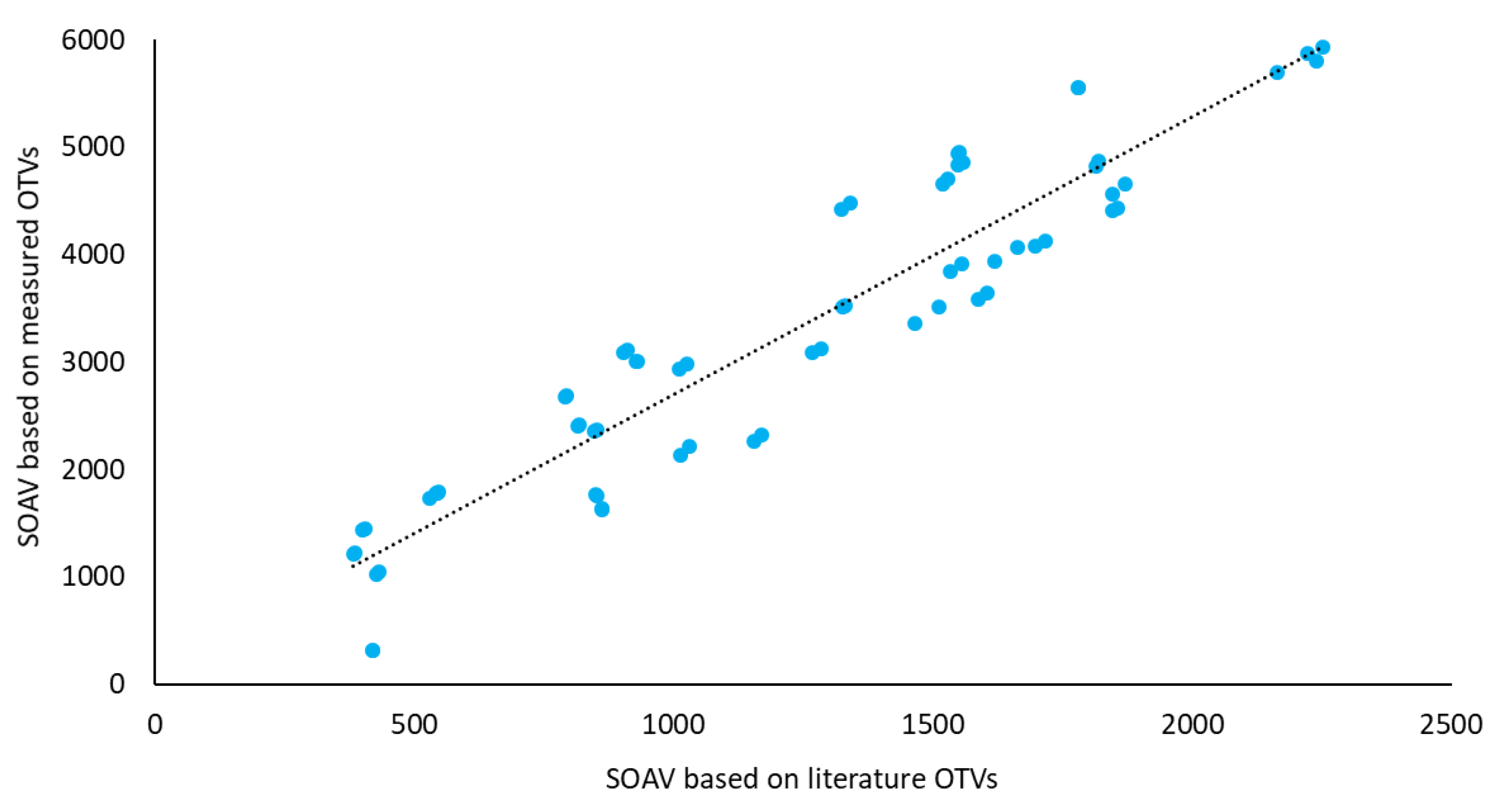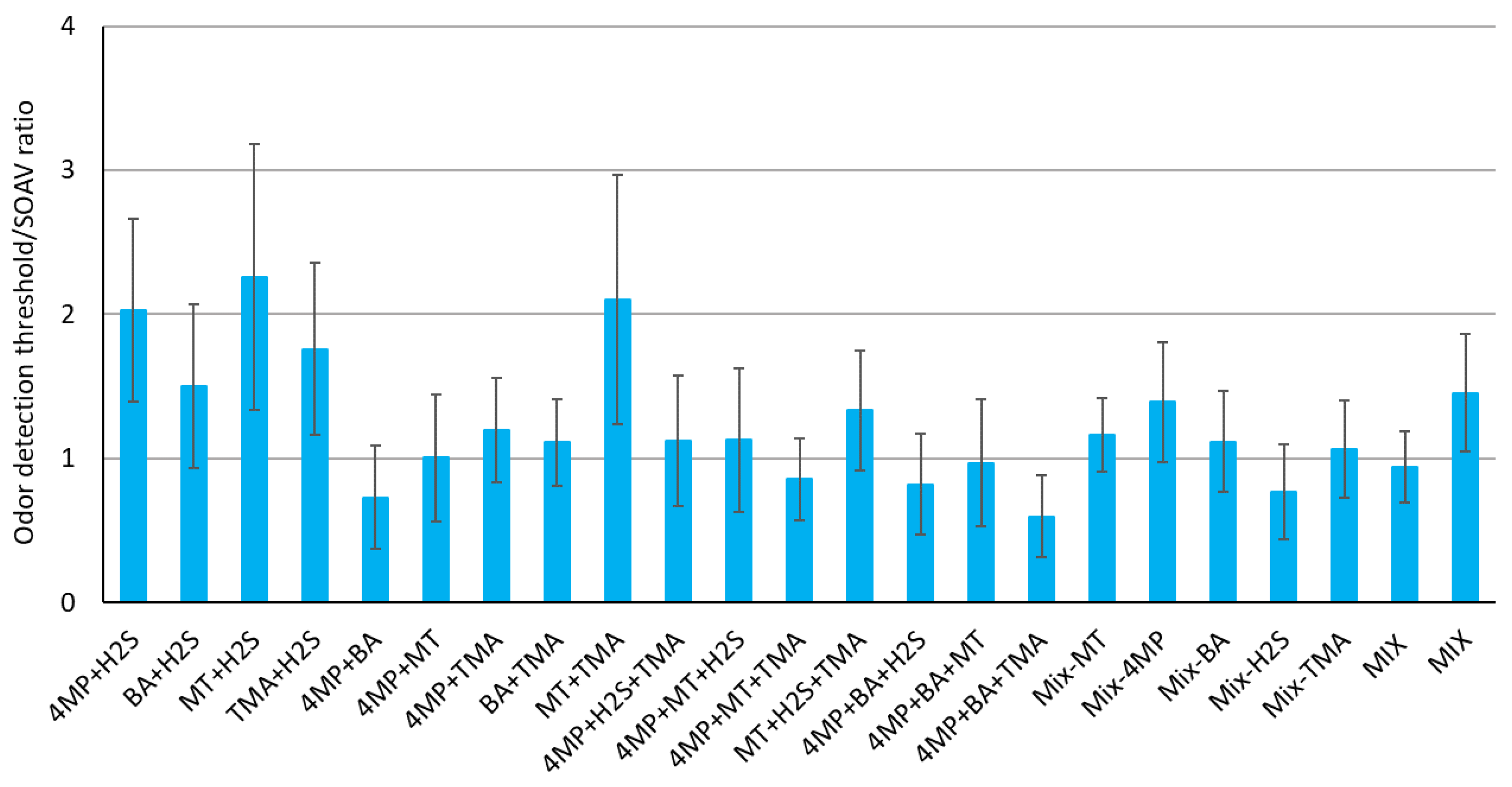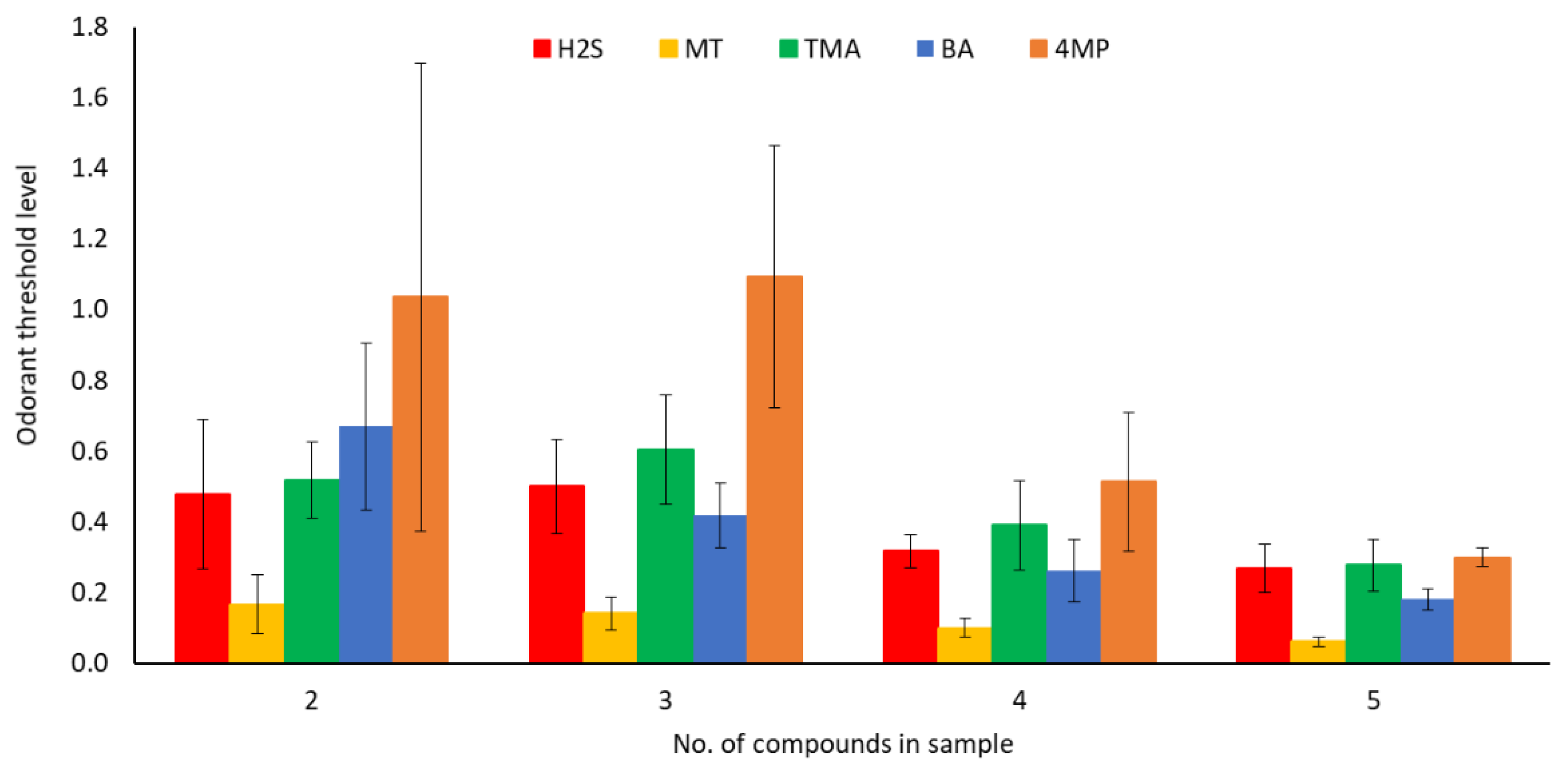Additivity between Key Odorants in Pig House Air
Abstract
1. Introduction
2. Materials and Methods
2.1. Gas Dilution System
2.2. Analytical Methods
2.3. Experimental Setup
2.4. Data Analysis
3. Results
3.1. Odor Threshold Values for Odorants
3.2. Additivity between Odorants
4. Discussion
Author Contributions
Funding
Institutional Review Board Statement
Informed Consent Statement
Data Availability Statement
Acknowledgments
Conflicts of Interest
References
- CEN. Air Quality—Determination of Odour Concentration by Dynamic Ofactometry; EN 13725; European Committee for Standardization: Brussels, Belgium, 2003. [Google Scholar]
- Hansen, M.J.; Adamsen, A.P.S.; Feilberg, A.; Jonassen, K.E.N. Stability of odorants from pig production in sampling bags for olfactometry. J. Environ. Qual. 2011, 40, 1096–1102. [Google Scholar] [CrossRef]
- Kasper, P.L.; Oxbøl, A.; Hansen, M.J.; Feilberg, A. Mechanisms of Loss of Agricultural Odorous Compounds in Sample Bags of Nalophan, Tedlar, and PTFE. J. Environ. Qual. 2018, 47, 246–253. [Google Scholar] [CrossRef] [PubMed]
- Kim, K.H.; Ju, D.W.; Joo, S.W. The evaluation of recovery rate associated with the use of thermal desorption systems for the analysis of atmospheric reduced sulfur compounds (RSC) using the GC/PFPD method. Talanta 2005, 67, 955–959. [Google Scholar] [CrossRef] [PubMed]
- Trabue, S.L.; Anhalt, J.C.; Zahn, J.A. Bias of Tedlar bags in the measurement of agricultural odorants. J. Environ. Qual. 2006, 35, 1668–1677. [Google Scholar] [CrossRef]
- Hansen, M.J.; Adamsen, A.P.S.; Feilberg, A. Recovery of Odorants from an Olfactometer Measured by Proton-Transfer-Reaction Mass Spectrometry. Sensors 2013, 13, 7860–7861. [Google Scholar] [CrossRef]
- Kasper, P.; Mannebeck, D.; Oxbøl, A.; Nygaard, J.; Hansen, M.J.; Feilberg, A. Effects of Dilution Systems in Olfactometry on the Recovery of Typical Livestock Odorants Determined by PTR-MS. Sensors 2017, 17, 1859. [Google Scholar] [CrossRef] [PubMed]
- Feilberg, A.; Hansen, M.J.; Pontoppidan, O.; Oxbøl, A.; Jonassen, K. Relevance of n-butanol as a reference gas for odorants and complex odors. Water Sci. Technol. 2018, 77, 1751–1756. [Google Scholar] [CrossRef] [PubMed]
- Klarenbeek, J.V.; Ogink, N.W.M.; van der Voet, H. Odor measurements according to EN 13725: A statistical analysis of variance components. Atmos. Environ. 2014, 86, 9–15. [Google Scholar] [CrossRef]
- Feilberg, A.; Liu, D.; Adamsen, A.P.S.; Hansen, M.J.; Jonassen, K.E.N. Odorant Emissions from Intensive Pig Production Measured by Online Proton-Transfer-Reaction Mass Spectrometry. Environ. Sci. Technol. 2010, 47, 5894–5900. [Google Scholar] [CrossRef] [PubMed]
- Hansen, M.J.; Liu, D.; Guldberg, L.B.; Feilberg, A. Application of Proton-Transfer-Reaction Mass Spectrometry to the Assessment of Odorant Removal in a Biological Air Cleaner for Pig Production. J. Agric. Food Chem. 2012, 60, 2599–2606. [Google Scholar] [CrossRef]
- Liu, D.; Feilberg, A.; Adamsen, A.P.S.; Jonassen, K.E.N. The effect of slurry treatment including ozonation on odorant reduction measured by in-situ PTR-MS. Atmos. Environ. 2011, 45, 3786–3793. [Google Scholar] [CrossRef]
- Guadagni, D.G.; Buttery, R.G.; Okano, S.; Burr, H.K. Additive Effect of Sub-Threshold Concentrations of Some Organic Compounds Associated with Food Aromas. Nature 1963, 200, 1288–1289. [Google Scholar] [CrossRef]
- Laska, M.; Hudson, R. A comparison of the detection thresholds of odour mixtures and their components. Chem. Senses 1991, 16, 651–662. [Google Scholar] [CrossRef]
- Patterson, M.Q.; Stevens, J.C.; Cain, W.S.; Cometto-Muñiz, J.E. Detection thresholds for an olfactory mixture and its three constituent compounds. Chem. Senses 1993, 18, 723–734. [Google Scholar] [CrossRef]
- Parker, D.B.; Koziel, J.A.; Cai, L.; Jacobson, L.D.; Akdeniz, N.; Bereznicki, S.D.; Lim, T.T.; Caraway, E.A.; Zhang, S.; Hoff, S.J.; et al. Odor and Odorous Chemical Emissions from Animal Buildings: Part 6. Odor Activity Value. Trans. ASABE 2012, 55, 2357–2368. [Google Scholar] [CrossRef]
- Trabue, S.; Kerr, B.; Bearson, B.; Ziemer, C. Swine Odor Analyzed by Odor Panels and Chemical Techniques. J. Environ. Qual. 2011, 40, 1510–1520. [Google Scholar] [CrossRef]
- Trabue, S.L.; Scoggin, K.D.; Li, H.; Burns, R.; Xin, H.W. Field sampling method for quantifying odorants in humid environments. Environ. Sci. Technol. 2008, 42, 3745–3750. [Google Scholar] [CrossRef]
- Wu, C.; Liu, J.; Zhao, P.; Piringer, M.; Schauberger, G. Conversion of the chemical concentration of odorous mixtures into odour concentration and odour intensity: A comparison of methods. Atmos. Environ. 2016, 127, 283–292. [Google Scholar] [CrossRef]
- Chappuis, C.J.-F.o.; Niclass, Y.; Vuilleumier, C.; Starkenmann, C. Quantitative Headspace Analysis of Selected Odorants from Latrines in Africa and India. Environ. Sci. Technol. 2015, 49, 6134–6140. [Google Scholar] [CrossRef]
- Cometto-Muñiz, J.E.; Abraham, M.H. Structure-activity relationships on the odor detectability of homologous carboxylic acids by humans. Exp. Brain Res. 2010, 207, 75–84. [Google Scholar] [CrossRef] [PubMed]
- Czerny, M.; Brueckner, R.; Kirchhoff, E.; Schmitt, R.; Buettner, A. The Influence of Molecular Structure on Odor Qualities and Odor Detection Thresholds of Volatile Alkylated Phenols. Chem. Senses 2011, 36, 539–553. [Google Scholar] [CrossRef]
- Hansen, M.J.; Kasper, P.; Adamsen, A.; Feilberg, A. Key Odorants from Pig Production Based on Improved Measurements of Odor Threshold Values Combining Olfactometry and Proton-Transfer-Reaction Mass Spectrometry (PTR-MS). Sensors 2018, 18, 788. [Google Scholar] [CrossRef] [PubMed]
- Miyazawa, T.; Gallagher, M.; Preti, G.; Wise, P.M. Odor Detection of Mixtures of Homologous Carboxylic Acids and Coffee Aroma Compounds by Humans. J. Agric. Food Chem. 2009, 57, 9895–9901. [Google Scholar] [CrossRef] [PubMed]
- Nagata, Y. Measurement of odor threshold by triangle odor bag method. In Odor Measurement Review; Ministry of the Environment, Goverment of Japan: Kawasaki City, Japan, 2003; pp. 118–127. [Google Scholar]
- Wise, P.M.; Miyazawa, T.; Gallagher, M.; Preti, G. Human odor detection of homologous carboxylic acids and their binary mixtures. Chem. Senses 2007, 32, 475–482. [Google Scholar] [CrossRef][Green Version]
- De Gouw, J.; Warneke, C. Measurements of volatile organic compounds in the earth’s atmosphere using proton-transfer-reaction mass spectrometry. Mass Spectrom. Rev. 2007, 26, 223–257. [Google Scholar] [CrossRef]
- Liu, D.; Nyord, T.; Rong, L.; Feilberg, A. Real-time quantification of emissions of volatile organic compounds from land spreading of pig slurry measured by PTR-MS and wind tunnels. Sci. Total Environ. 2018, 639, 1079–1087. [Google Scholar] [CrossRef] [PubMed]
- Hansen, M.J.; Jonassen, K.E.N.; Feilberg, A. Evaluation of abatement technologies for pig houses by dynamic olfactometry and on-site mass spectrometry. Chem. Eng. Trans. 2014, 40, 253–258. [Google Scholar]
- Cometto-Muñiz, J.E.; Cain, W.S.; Abraham, M.H. Odor detection of single chemicals and binary mixtures. Behav. Brain Res. 2005, 156, 115–123. [Google Scholar] [CrossRef]




| Compound 1 | H2S 2 | MT | TMA | BA | 4MP |
|---|---|---|---|---|---|
| m/z | 35 | 49 | 60 | 89 + 71 | 109 |
| Reaction rate constant [28], cm3 molecule−1 s−1 | - | 1.9 × 10−9 | 1.58 × 10−9 | 2.11 × 10−9 | 2.32 × 10−9 |
| Concentration, ppbv | 319 ± 21 | 14 ± 1 | 33 ± 1 | 88 ± 9 | 11 ± 2 |
| Compound 1 | H2S | MT | TMA | BA | 4MP |
|---|---|---|---|---|---|
| Measured OTV | 0.2 | 0.04 | 0.02 | 0.1 | 0.006 |
| [0.06; 1] | [0.01; 0.1] | [0.01; 0.07] | [0.02; 0.4] | [0.003; 0.03] | |
| Literature [23] OTV | 0.8 | 0.03 | 0.08 | 0.2 | 0.02 |
| [0.4; 3] | [0.02; 0.07] | [0.03; 0.2] | [0.1; 0.8] | [0.005; 0.05] |
Publisher’s Note: MDPI stays neutral with regard to jurisdictional claims in published maps and institutional affiliations. |
© 2021 by the authors. Licensee MDPI, Basel, Switzerland. This article is an open access article distributed under the terms and conditions of the Creative Commons Attribution (CC BY) license (https://creativecommons.org/licenses/by/4.0/).
Share and Cite
Hansen, M.J.; Adamsen, A.P.S.; Wu, C.; Feilberg, A. Additivity between Key Odorants in Pig House Air. Atmosphere 2021, 12, 1008. https://doi.org/10.3390/atmos12081008
Hansen MJ, Adamsen APS, Wu C, Feilberg A. Additivity between Key Odorants in Pig House Air. Atmosphere. 2021; 12(8):1008. https://doi.org/10.3390/atmos12081008
Chicago/Turabian StyleHansen, Michael Jørgen, Anders Peter S. Adamsen, Chuandong Wu, and Anders Feilberg. 2021. "Additivity between Key Odorants in Pig House Air" Atmosphere 12, no. 8: 1008. https://doi.org/10.3390/atmos12081008
APA StyleHansen, M. J., Adamsen, A. P. S., Wu, C., & Feilberg, A. (2021). Additivity between Key Odorants in Pig House Air. Atmosphere, 12(8), 1008. https://doi.org/10.3390/atmos12081008







